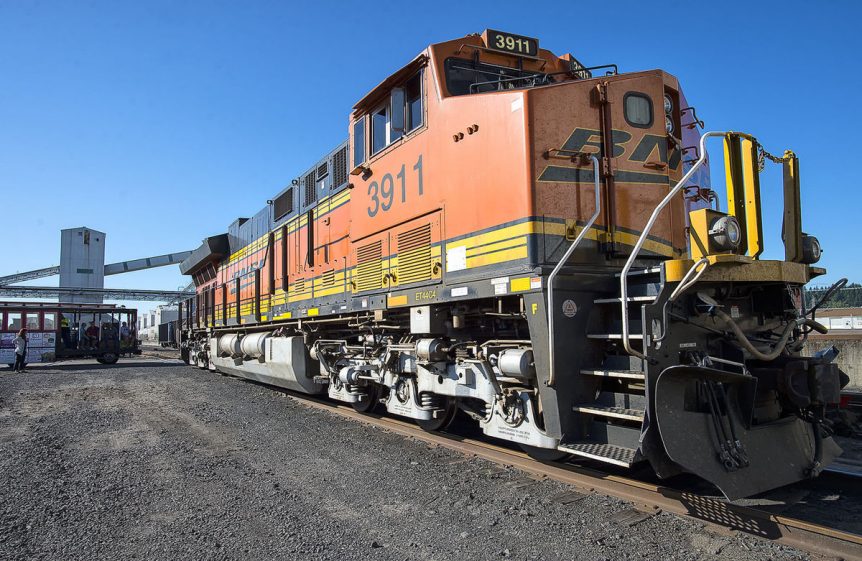State study suggests coal trains increase risk; BNSF disagrees
By Marissa Luck, Reporter at The Daily News
Editor’s note: This is the first in a three-part series that will appear in coming weeks about whether trains serving the proposed Millennium Bulk Terminals coal terminal will increase cancer risks.
It was bright, orange and powerful. A 74-foot-long BNSF Railway locomotive, capable of hauling 20 loaded coal cars, shone in the sun on the Millennium Bulk Terminals’ tracks at a recent company summer barbecue. Kids ogled at the locomotive and asked if they could climb aboard.
“There is nothing more visual than one of our orange locomotives. It’s like a big orange pumpkin,” jokes Courtney Wallace, spokeswoman for BNSF Railway.
The new locomotive, which BNSF says is 90 percent cleaner than the previous generation of railway engines, showcased how BNSF is cutting its carbon footprint and emissions. But the display served another purpose: to promote a more positive image of the locomotives just months after a state/county study concluded that locomotive exhaust from the trains serving the proposed giant coal terminal would increase cancer risks in Longview.
The study, co-lead by the state Department of Ecology and Cowlitz County, estimated that trains carrying coal to Millennium could increase the risk of cancer by 10 percent for people living in Longview’s Highlands neighborhood, which is along the path to the proposed terminal. The risk could jump to 16 percent for those closest to the tracks and dips to 3 percent for most of Kelso and Longview.
Coal opponents latched on to those statistics as further evidence of the terminal’s detrimental impact on public health. Yet BNSF says those statistics are misleading and overlook the work the railroad company is doing to make its fleet cleaner.
“We are always committed to having the most fuel-efficient, environmentally friendly fleet,” Wallace said. “Trains have long been a great way to move all types of good by land. By using long-haul trains, by having fewer trucks on the road, we actually help to reduce emissions.”
The study — the Final Environmental Impact (FEIS) study of the coal proposal — could have repercussions for future industrial projects in Washington, if the state begins to evaluate and consider diesel emissions from trains carrying other cargo. It also raises questions about the health risks Washingtonians already are exposed to from diesel emissions, and whether or how increased regulations can curb those risks. The Daily News will take a look at some of these questions in a series of articles over the coming weeks.
Cancer risk rates
The FEIS uses a complex array of models and statistical probabilities to estimate and express how the risk of cancer would rise as result of the increased train traffic. And, like most cancer analyses, it is conservative, assuming that the affected population is exposed all day, every day for 70 years. In fact, the terminal would cause 16 trains a day to transit the rail corridor adjacent to the Highlands area.
Because there are no existing studies of how inhaling diesel particulate matter affects cancer risk in Cowlitz County, the study applies a federal model developed for California to set a baseline level of cancer risk from diesel locomotive emissions here.
The risk ratio is expressed by the number of cancer cases per a population of 1 million people. But boiled down to a population the size of the local area, the estimates are actually much smaller than they may seem at first blush. For a city the size of Longview, there would be about one or two additional cancer cases over the span of a lifetime as a result of the increased coal train traffic. The risk increases slightly the closer someone lives to the train tracks. (See sidebar.)
It’s worth noting, though, that even if the coal plant is built, Highlands-area residents would still be exposed to less locomotive diesel exhaust than residents of, say, North and South Kelso, through which some 60 freight trains pass daily.
Diesel powers buses, trucks, trains, many pickups and a small percentage of cars. It’s pervasive presence makes it easy to forget its harmful health effects. A 2007 study identified diesel particulate matter as the most likely contributor to cancer risk in Washington state, according to the FEIS. Yet it wasn’t until 2012 that the World Health Organization classified diesel exhaust as carcinogenic.
Diesel exhaust is packed with nitrogen oxides and thousands of hydrocarbon compounds, including 40 cancer-causing chemicals, according to the Washington State Department of Ecology.
The tiny particles in diesel exhaust are too small for human noses and respiratory systems to filter and block. It’s impossible to avoid breathing the particles deep into the lungs, where they can inflict damage and cause chemical changes.
Breathing diesel exhaust cause cancer,and it’s known to have a variety of other immediate and long-term health effects: heart attack and stroke in people with heart disease; asthma attacks and worsening asthma; increased risk of respiratory infections; impaired lung growth in children; worsening allergic reactions; eye, nose and throat irritation along with coughing, labored breathing, chest tightness and wheezing; birth defects and male infertility.
Already Cowlitz County ranks poorly in many health measures, and increasing exposure to diesel particulate matter could only make matters worse, said Regna Merritt, retired physician’s assistant with Oregon Physicians for Social Responsibility.
According to the American Lung Association estimates, there are about 9,300 people with asthma and 4,700 adults with chronic obstructive pulmonary disease (COPD) in Cowlitz County. The aging population in the county could also make residents here more susceptible to respiratory illness, Merritt said.
“While we see and hear air quality in Cowlitz County has improved over time, this project would take us in the wrong direction,” Merritt added.
Can new engines combat these risks?
BNSF Railway argues that Ecology’s study fails to consider the fact that its fleet is increasingly more fuel efficient and cleaner. According to BNSF, the FEIS also assumed that locomotives would be running and idling continuously, in spite of the fact that 98 percent of the company’s fleet has idle-control mechanisms that shut off locomotives when they’re not in use (except in extremely cold temperatures).
Under federal regulations, locomotives made after 2015 must comply with stricter “Tier 4 standards” designed by the U.S. Environmental Protection Agency. The Tier 4 standards reduce emissions of air pollutants by 70 percent compared to the previous generation of locomotives. And the newest locomotives produce 90 percent fewer emissions than the engines of 15 years ago, according to BNSF.
In 2015 alone, BNSF added 300 new, more energy-efficient locomotives to its fleet that meet the stricter standards, and now the company is up to 550 locomotives that are Tier-4 compliant. Plus, about 40 percent of the company’s locomotives were purchased in the last 10 years.
Using freight trains can also cut emissions compared to hauling cargo with trucks, Wallace pointed out. One double-stacked freight train is equivalent to about 280 trucks, according to BNSF.
That means less traffic congestion and less idling time for passenger vehicles too, pointed out Jessica Kahanek of the American Association of Railroads. On average, trains are four times more fuel-efficient than trucks, Kahanek said, which reduces diesel consumption and emissions overall.
Locomotives are built to last 30 to 40 years, but each BNSF locomotive is remanufactured every six to eight years to meet the EPA’s latest standards.
While the rail company can’t guarantee how soon all its locomotives will meet Tier 4 standards, “the vast majority” of the fleet will comply with the stricter regulations by the time the Millennium coal terminal is running, Wallace said. However, because BNSF’s can’t guarantee that, the state/county study used EPA estimates of emissions based on the agency’s own projections of how quickly the railroad company will transition to the latest, toughest emission standards, said Ecology Department spokesman David Bennett.
And what’s not clear is how much these Tier 4 standards will actually lower the risk of cancer from diesel particulate matter. Any substantial increase in train traffic that introduces a significant amount of new diesel particulate matter emissions into the county isn’t a win for public health, opponents say.
“Diesel particulate matter is deadly; the prescription here is prevention,” Merritt said.
Read original article, here.


